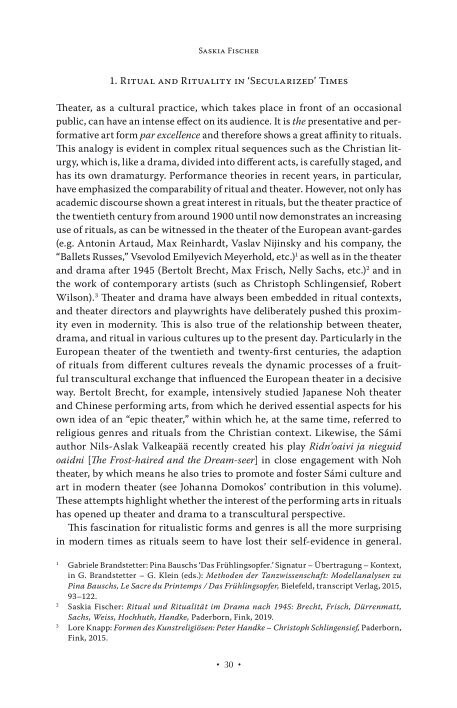
Page 32 [32]

OCR
SASKIA FISCHER 1. RITUAL AND RITUALITY IN ‘SECULARIZED’ TIMES Theater, as a cultural practice, which takes place in front of an occasional public, can have an intense effect on its audience. It is the presentative and performative art form par excellence and therefore shows a great affinity to rituals. This analogy is evident in complex ritual sequences such as the Christian liturgy, which is, like a drama, divided into different acts, is carefully staged, and has its own dramaturgy. Performance theories in recent years, in particular, have emphasized the comparability of ritual and theater. However, not only has academic discourse shown a great interest in rituals, but the theater practice of the twentieth century from around 1900 until now demonstrates an increasing use of rituals, as can be witnessed in the theater of the European avant-gardes (e.g. Antonin Artaud, Max Reinhardt, Vaslav Nijinsky and his company, the “Ballets Russes,” Vsevolod Emilyevich Meyerhold, etc.)! as well as in the theater and drama after 1945 (Bertolt Brecht, Max Frisch, Nelly Sachs, etc.)? and in the work of contemporary artists (such as Christoph Schlingensief, Robert Wilson).* Theater and drama have always been embedded in ritual contexts, and theater directors and playwrights have deliberately pushed this proximity even in modernity. This is also true of the relationship between theater, drama, and ritual in various cultures up to the present day. Particularly in the European theater of the twentieth and twenty-first centuries, the adaption of rituals from different cultures reveals the dynamic processes of a fruitful transcultural exchange that influenced the European theater in a decisive way. Bertolt Brecht, for example, intensively studied Japanese Noh theater and Chinese performing arts, from which he derived essential aspects for his own idea of an “epic theater,” within which he, at the same time, referred to religious genres and rituals from the Christian context. Likewise, the Sami author Nils-Aslak Valkeapää recently created his play Ridn'oaivi ja nieguid oaidni |The Frost-haired and the Dream-seer] in close engagement with Noh theater, by which means he also tries to promote and foster Sami culture and art in modern theater (see Johanna Domokos’ contribution in this volume). These attempts highlight whether the interest of the performing arts in rituals has opened up theater and drama to a transcultural perspective. This fascination for ritualistic forms and genres is all the more surprising in modern times as rituals seem to have lost their self-evidence in general. 1 Gabriele Brandstetter: Pina Bauschs ‘Das Frihlingsopfer.’ Signatur — Ubertragung — Kontext, in G. Brandstetter — G. Klein (eds.): Methoden der Tanzwissenschaft: Modellanalysen zu Pina Bauschs, Le Sacre du Printemps / Das Frithlingsopfer, Bielefeld, transcript Verlag, 2015, 93-122. ? Saskia Fischer: Ritual und Ritualität im Drama nach 1945: Brecht, Frisch, Dürrenmatt, Sachs, Weiss, Hochhuth, Handke, Paderborn, Fink, 2019. 3 Lore Knapp: Formen des Kunstreligiösen: Peter Handke - Christoph Schlingensief, Paderborn, Fink, 2015. +30 °
structurelles
Custom
Image Metadata
- Largeur de l'image
- 1830 px
- Hauteur de l'image
- 2834 px
- Résolution de l'image
- 300 px/inch
- Taille du fichier d'origine
- 1.25 MB
- Lien permanent vers jpg
- 022_000047/0031.jpg
- Lien permanent vers OCR
- 022_000047/0031.ocr
